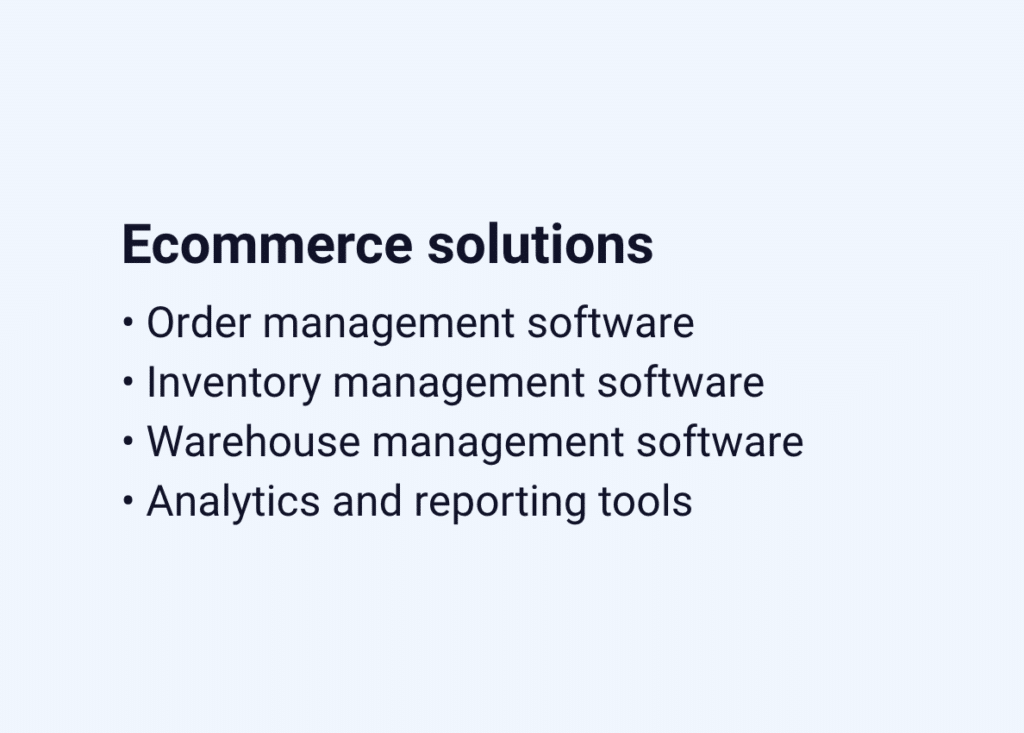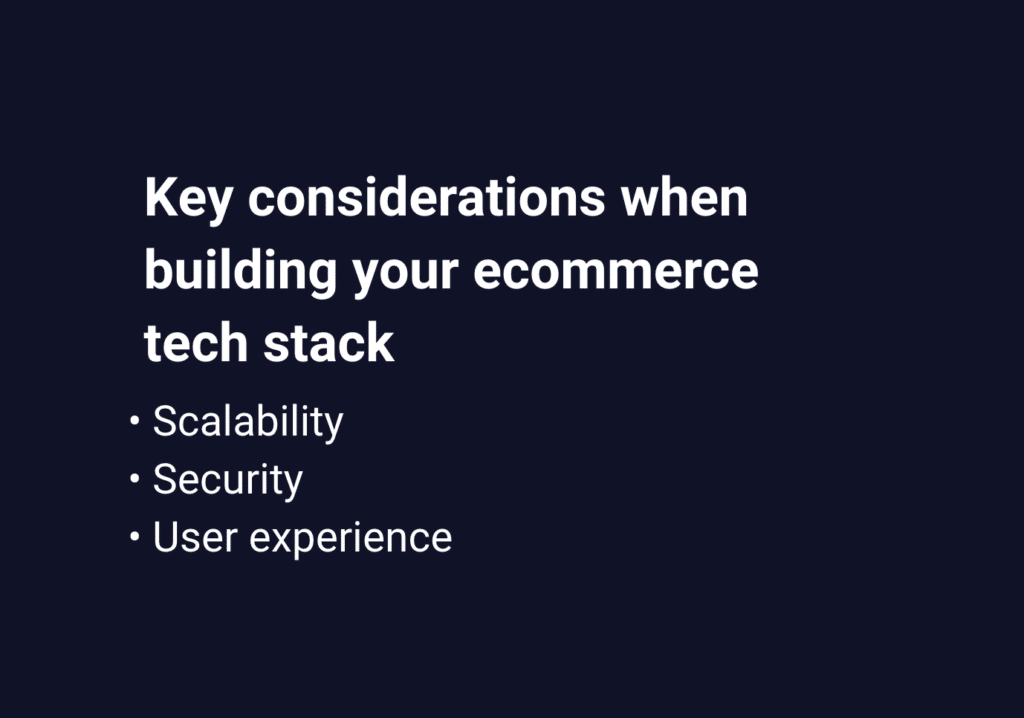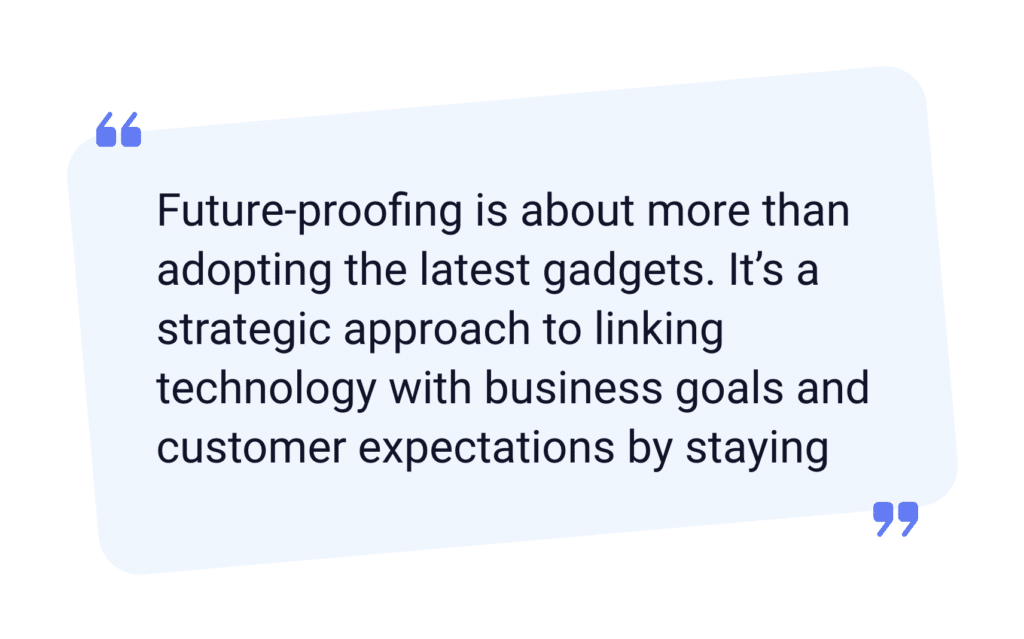How to craft an ecommerce tech stack that scales with you
In the digital marketplace, the only thing faster than your shipping should be your ecommerce tech stack. But with myriad options to choose from, finding the right mix of solutions that work harmoniously for your business can be as challenging as deciphering your great aunt’s cryptic emojis!
But fear not. Our team of software experts (or geeks, if you will) have done all the research legwork for you to make the process of choosing the right tech stack a walk in the park.
Ready to get down to brass tacks? Then, let’s dive in.
What is an ecommerce tech stack?
In the intricate dance between pixels and programming, your ecommerce tech stack takes center stage. It’s essentially the tech version of the backstage crew at a concert, making sure the show runs seamlessly and leaves your audience in awe.
More specifically, it’s a curated collection of software applications, strategically stacked to handle various aspects of your digital storefront. From lead generation and payment processing to warehouse management and inventory analytics, your ecommerce tech stack forms the backbone of your digital empire. The overarching goal is to make sure every click, purchase, and interaction happens seamlessly, giving you more time to focus on the bigger picture, brainstorm your next genius idea, and practice your victory dance (our vote’s on twerking).
Even more specifically? OK, picture the chain of events when a customer arrives on your sales site. These are the jobs that an effective ecommerce tech stack can automate:
- Keeping track of browsing preferences and purchase histories, turning even the most on-the-fence shopper into a loyal patron.
- Facilitating secure and hassle-free payments, providing consumers the confidence to click that all-important ‘Buy Now’ button.
- Initiating the order management process to help warehouse teams pick, pack, and ship at breakneck speed.
- Preventing dreaded stockouts or overstocking by foolproofing your inventory management procedures.
- Turning raw data into actionable insights to help you steer your business in an even more impressive upward trajectory.
Components of an optimized ecommerce tech stack
When you find that perfect Goldilocks balance, your ecommerce tech stack isn’t a jumble of disconnected tools. It’s a well-choreographed ensemble, where each component plays a vital role in ensuring your online store doesn’t simply survive, but thrives. Here’s a rundown of all the essential elements.
Payment processing solutions
Let’s talk moolah! After all, secure payments are the heartbeat of any ecommerce venture and the key to keeping your virtual cash register ringing.
The equation you need to master here is a simple one: Security + convenience = trust.
A secure payment process isn’t just a shield against cyber threats. It’s a beacon that attracts customers by providing a digital vault into which they’re happy to entrust their financial details.
Convenience, on the other hand, is the red carpet leading to customer satisfaction. It’s all about providing a seamless checkout experience, reducing friction, and making the process as easy as a Sunday morning.
Leading payment gateways and their features
Let’s meet a few stars of the show—the payment gateways. Here are some examples of top digital bouncers you can employ to ensure only legitimate transactions make it through the VIP entrance:
- PayPal – This seasoned maestro of online payments is well known for its widespread acceptance and buyer protection features.
- Stripe – The cool kid on the block, offering a developer-friendly platform, seamless integration, and global reach.
- Square – The avant-garde artisan, specializing in in-person and online transactions with its sleek, square-shaped card readers.
- Braintree – The tech-savvy cousin, providing seamless and customizable integrations for tailor-made payment experiences.
Customer relationship management (CRM) Tools
In today’s competitive environment, personalized experiences reign supreme. So, incorporating CRM tools into your ecommerce tech stack is vital if you’re to turn one-time shoppers into forever fans. They help you centralize and analyze customer data across various touchpoints to gain a holistic view of consumer sentiment, preferences, and behaviors.
Think of CRM tools as fairy godparents, constantly working to optimize customer relationships. Only, unlike real-life godparents, they’ll never forget your customer’s birthdays! Plus, they’ll collect, analyze, and present all the data you need to:
- Send customized offers based on product clicks.
- Cross-sell new products based on previous purchases.
- Notify consumers when wish list items go on sale.
- Send discount codes to customers at risk of churn.
- Provide aftersales support.
Introducing the CRM pack leaders
Here’s a quick overview of some of the leading CRM systems available for your ecommerce tech stack and their unique value propositions:
- Salesforce – The charismatic leader in the CRM realm, offering a comprehensive, all-in-one suite of tools that can scale with your business.
- HubSpot – The inbound marketing magician, blending seamlessly with marketing automation to help you attract and engage customers through personalized content.
- Zoho CRM – The Swiss Army knife of CRM, this user-friendly interface with advanced features packs a punch without breaking the bank, making it popular with small to medium-sized businesses.
- Microsoft Dynamics 365 – The seamless integrator, effortlessly integrating with other Microsoft tools, making it a go-to option for businesses deeply embedded in the Microsoft ecosystem.
Ecommerce solutions


In the grand theater of ecommerce, where transactions are the scenes and products the actors, having a well-orchestrated set of tech solutions is as essential as glitter at a carnival parade. From ensuring each product hits the stage on time to managing your props (AKA inventory), these solutions are the unsung heroes, working tirelessly behind the scenes to make your online business a blockbuster.
Order management software
Order management software is the choreographer of your ecommerce ballet. Customers expect their products to pirouette effortlessly from cart to doorstep. A robust order management system is the linchpin that makes that happen. It doesn’t just process your orders. It prevents missteps due to overselling and eliminates unnecessary pauses caused by backorders.
Inventory management software
As the tenured backstage manager, inventory management software makes sure the show always goes on without a hitch. But it’s not just about counting products. The best inventory management systems also help you prevent dramatic twists caused by stockouts and unnecessary charges due to the excess baggage of overstocking.
Warehouse management software
Ever wish your warehouse could run itself? Enter warehouse management software—the digital foreman that transforms that wishful thinking into reality. From managing stock levels to optimizing storage space, warehouse management software is the unsung hero that works 24/7 to ensure every product is ready for its moment in the spotlight.
Analytics and reporting tools
In today’s data-driven era, making informed decisions isn’t just a choice; it’s a strategic imperative. Data analytics tools aren’t exactly a crystal ball, but they’re the closest thing to it. By understanding your audience’s applause and predicting plot twists in market trends like a pro, they help you adjust the script for your ecommerce success story like a meticulous playwright.
Integrations and APIs
Alright, here comes the techy bit. But don’t sweat it. Understanding the nitty gritty of integration and Application Programming Interface (API) elements of your ecommerce tech stack doesn’t require a degree in rocket science or the ability to understand hieroglyphics. We’re here to break it down for you with a big old dollop of simplicity – minus the confusing jargon.
The short version: Integration is the process of making independently-designed systems communicate with each other. APIs are the technology that allows that to happen by allowing developers to build applications that talk to each other.
But of course, there is a more comprehensive version (but still no tech dictionary needed, we promise!).
The power of ecommerce integrations
If you sell across multiple channels, integration is essential. Let’s say you sell on Amazon, WooCommerce, and Walmart marketplaces. Updating your inventory in real-time to maintain control of stock levels is critical. But doing everything manually is time-consuming, error-prone, and generally just a massive headache.
Integrations are the magical connectors that ensure you’re on the same page across every platform via effortless data sharing. Rocking ecommerce integration is a bit like having a universal remote for each of your sales funnels —yay to no more fumbling with separate controls! Plus, besides the basics of inventory management, integration ensures all of your teams know what the others are doing. Think of it as having an automated company-wide group chat where everyone stays informed around the clock – but without having to drown in emails to stay updated!
Allow us to give you an example while indulging in some shameless self-promotion! Linnworks integrations offer a seamless bridge to hundreds of global marketplaces, D2C platforms, shipping providers, and 3PLs.
APIs and their significance
Let’s talk APIs, the translators for your digital systems. While the typical user interface is intended for human use, APIs are designed for use by an application or computer. Essentially, they comprise a set of rules that define how all of your systems talk to each other.
In layman’s terms, all of the software in your ecommerce tech stack speaks a different language. APIs are the interpreters, connecting your website, accounting software, inventory tools, etc., so that they all speak the same tech language, allowing data to flow effortlessly between each element.
Here’s a working example (with just a teensy bit more self-promotion for ultimate ease of understanding). The Linnworks API platform allows developers to create and host multiple host API endpoints that function by:
- Calling the API of another application
- Retrieving data from a database
- Downloading files to look up information.
- Performing specific business logic.
The result? When you implement new automations, you don’t have to worry that the parameters you’re using are based on outdated or out-of-sync data.
Considerations when building your ecommerce tech stack


Building the perfect ecommerce tech stack can sometimes feel like being a kid in a candy shop – so many enticing options! So, how do you pick the perfect combination without blowing your budget or settling for a cheaper combo that you think will get you more, only to regret it later when the quality turns out to be subpar?
Here’s a rundown of the top three considerations: scalability, security, and user experience.
Scalability
The key here is to plan for growth without outgrowing your technology. After all, you don’t want your ecommerce tech stack to feel like last season’s smartphone when everyone else has the latest model. To ensure optimum scalability, you should:
- Consider compatibility with your current tools and other platforms you may wish to use in the future.
- Assess how each tech component handles increased traffic and data.
- Look for solutions with customizable features that cater to your business’s unique needs and processes.
Security
If you want to keep your customer’s trust and protect yourself from cyber threats, strict data security protocols are as essential as your first caffeine fix on a dull Monday morning. It’s all about maximizing the value of your data while minimizing the risk of data breaches through careful planning, oversight, and control. For each component of your ecommerce tech stack, you’ll need to consider:
- End-to-end encryption capabilities.
- Multi-factor authentication protocols.
- Updates and patching procedures.
- User permissions and access controls.
- Incident response plans.
- Compliance with relevant industry security standards (GDPR, HIPAA, etc.).
User experience
Of course, there’s more to your ecommerce tech stack than functionality. It’s also about crafting user experiences that keep customers coming back for more. You’ve heard the phrase “it’s not what you say, but how you say it”? Well, in this case, it’s not what you’re selling but how you’re presenting it. To keep end users coming back for more, you need solutions that guarantee:
- Engaging visuals
- Intuitive navigation
- Mobile optimization
- Fast loading speed
- Clear CTAs
- Personalization
- Streamlined checkout processes
Future-proofing your tech stack


Future-proofing is about more than adopting the latest gadgets. It’s a strategic approach to linking technology with business goals and customer expectations by staying ahead of the curve. For example, three of the most significant criteria for business success based on current trends include adopting/providing:
- Omnichannel shopping – Where online and offline experiences across multiple devices and channels are unified.
- Personalization – Via tailored content and product recommendations.
- Ethical practices – There is growing demand for environmentally friendly and socially responsible products.
That said, there will always be emerging technologies that spring up to fulfill ever-evolving consumer needs. For example, options to include new and innovative ecommerce tech stack solutions like AI-powered augmented reality (AR), virtual reality, and voice and conversational ecommerce are already out there.
Sellers who come late to the party on new technology adoption can quickly lose market share to more forward-thinking competitors. So, early adoption is critical. The specific solutions that are right for you will depend on the intricacies of your business. However, here are a few top tips and general recommendations from our Linnworks geeks (ahem, experts) to help you stay one step ahead:
- Utilize data-driven analytics to better understand customer behavior, market trends, and performance metrics.
- Stay agile by continuously iterating and updating your tech stack based on evolving trends and customer needs.
- Automate procedures wherever possible to speed up processes and eliminate errors.
- Invest in real-time tracking to ensure accurate inventory levels, appropriate reorder points, and timely stock replenishment.
- Provide exemplary service with fast and reliable shipping options and transparent communication about delivery times.
- Offer flexible payments to maximize spending, including digital wallets and ‘buy now, pay later’ options.
- Leverage social proof by highlighting reviews and testimonials to build trust and influence purchasing decisions.
In Conclusion
If you haven’t picked up on it yet – or in case you’re the type who skips straight to the end paragraph for the TLDR version, the key point is this: Creating an ecommerce tech stack with the best features and integrations offers a wide range of business advantages – ultimately preparing you for success. From boosting and securing seamless payments to streamlining inventory management and customer support processes, each component is a strategic asset in your digital arsenal.
Want to learn more about ecommerce solutions that simplify your operations by bringing inventory and order management into one place? Check out Linnworks One today and request a free demo to discover how we can help.
